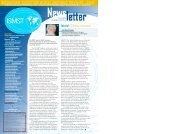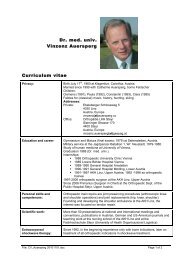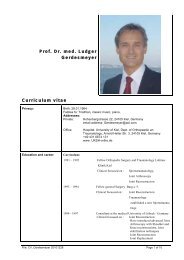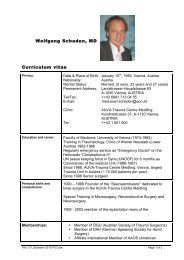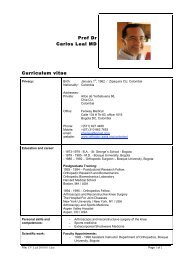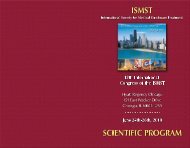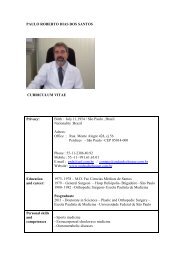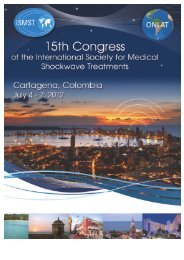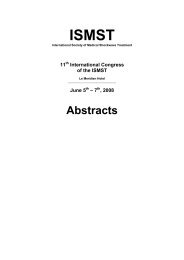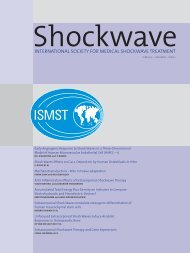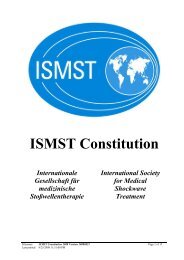Abstracts - ISMST - International Society for Medical Shockwave ...
Abstracts - ISMST - International Society for Medical Shockwave ...
Abstracts - ISMST - International Society for Medical Shockwave ...
You also want an ePaper? Increase the reach of your titles
YUMPU automatically turns print PDFs into web optimized ePapers that Google loves.
<strong>Abstracts</strong><br />
1. Potential Roles of Cavitation in Tissue Angiogenesis -<br />
Observations from Cavitation Monitoring during <strong>Shockwave</strong> Therapy<br />
Michael Chang<br />
Institution: Physical Medicine Institute, WA, USA<br />
Device and producing company: OssaTron (SanuWave), D-Actor (Storz <strong>Medical</strong>)<br />
Introduction: Cavitation may play an important role in <strong>Shockwave</strong> Therapy (SWT) bringing desirable biological responses,<br />
such as angiogenesis/regeneration, thrombolysis, or disrupting bacteria biofilms. There<strong>for</strong>e, designing SWT protocol<br />
including cavitation control is important to achieve desirable clinical outcomes.<br />
Methods: Real-time cavitation was monitored using B-mode ultrasonography during SWT <strong>for</strong> various chronic<br />
musculoskeletal conditions using either the OssaTron or D-Actor.<br />
Results: Occurrence of cavitation highly depends on shockwave applications as well as characteristics of the target tissue.<br />
Presence of cavitation is usually more obvious with SWT using a high-energy focused shockwave device than a low-energy<br />
unfocused pressure wave device. Cavitation is more easily seen in tissues with high fluid or vascular contents. Cavitation<br />
tends to scatter around soft tissue-bone interfaces or wherever there is high negative pressure. With high shockwave<br />
intensity, fast application rate and high cumulative pulses, persistent and wide spread cavitation within target tissue may be<br />
observed.<br />
Discussion: Cavitation often first occurs within blood vessels. There is apparent dynamic interaction between cavitation<br />
and shockwaves, exerting unique stress/stimulation on vascular cells. The stress may also disrupt vessel walls introducing<br />
intra-vascular contents into interstitial space, seeding wider spread cavitation. These events may participate in important<br />
bio-mechanisms <strong>for</strong> tissue angiogenesis. If excessive cavitation occurs, tissue/organ injury may result.<br />
Conclusion: <strong>Shockwave</strong>s exert their unique influence on vasculatures through both production of cavitation and interaction<br />
with the cavitation. Cavitation may prove to be one of the most important factors that should be carefully controlled to<br />
achieve safety and efficacy <strong>for</strong> future clinical applications of SWT in medicine. Further investigation into cavitation control in<br />
various clinical settings is needed.<br />
2. Energy transmission with radial pressure waves<br />
Pavel Novak<br />
Institution: Storz <strong>Medical</strong> AG, Tägerwilen, Switzerland<br />
Device and producing company: Masterpuls MP200, Storz <strong>Medical</strong> AG<br />
Introduction: Radial pressure waves are typically generated pneumatically when a projectile, accelerated by compressed<br />
air, hits a stationary transmitter. Pressure waves are usually referred to either as EPAT (Extracorporeal Pulse Activation<br />
Therapy), or as RSWT (Radial <strong>Shockwave</strong> Therapy). The “classification” as shock waves is (along with marketing issues)<br />
based on the fact that both wave types are mechanical pulses and their therapeutic effect is similar <strong>for</strong> many indications.<br />
As a result, the same physical parameters <strong>for</strong> their description (MPa, mJ/mm²) as well as the same measurement methods<br />
are used <strong>for</strong> radial pressure waves as <strong>for</strong> focused shock waves. This approach leads to misinterpretation, because radial<br />
pressure waves have significantly different physical properties (pulse amplitude, pulse shape, frequency range) than<br />
focused shock waves.<br />
Methods: Low frequency pressure waves cannot be measured in a water bath like shock or ultrasound waves can. They<br />
can only be measured by calibrated <strong>for</strong>ce transducer within a tissue phantom.<br />
Results: The measurements confirm that the energy transmitted into the tissue by low frequency pressure waves is<br />
significantly higher than the energy transmitted by the ultrasound pulse (which is generated in parallel) and has much lower<br />
penetration depth and energy.<br />
Discussion: Considering pressure waves as shock waves results in incorrect observations and is not consistent with<br />
observed biological effects. Observed therapeutic effects are due to the low frequency pressure waves.<br />
Conclusion: The attempt to consider and quantify the pressure waves as shock waves results in misinterpretation of the<br />
observed effects. It prevents recognizing and optimizing the true benefits achievable by pulse activation therapy (EPAT).<br />
11



